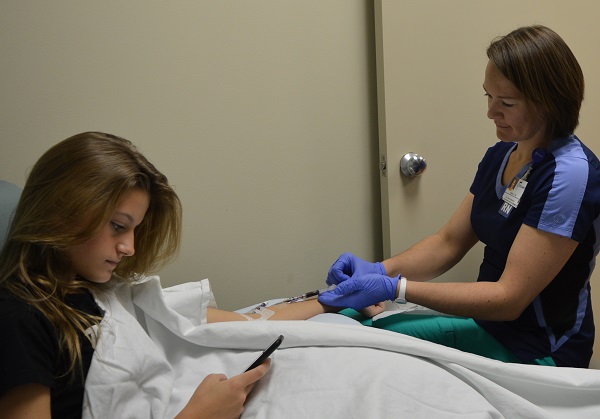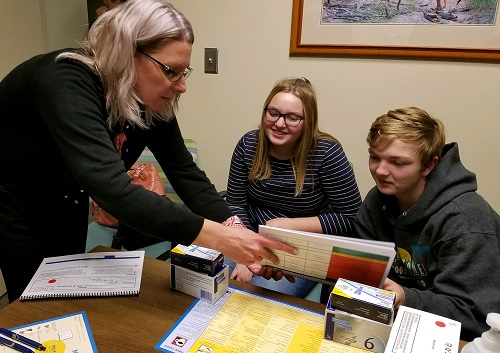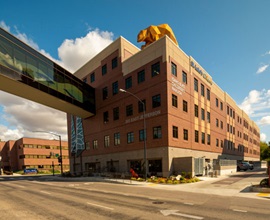Young St. Luke’s Diabetes Patients Participate in Cutting Edge National Research Studies

When St. Luke’s endocrinologist Dr. Daniel Flynn has to tell parents that their child has diabetes, one of the first questions they ask is if there is a cure.
Dr. Flynn, the medical director of St. Luke’s Children’s Endocrinology, hopes that one day the answer to that question will be “yes.”
While there isn’t a cure right now, the research conducted in the field of pediatric diabetes could pave the way. Research happening here at St. Luke’s could be part of that breakthrough, and it also is helping find answers to another question parents ask Dr. Flynn: “Will this happen to my other child?”
There are three clinical trials happening now at St. Luke’s Children’s Endocrinology:
- The Onset7 study is researching a rapid acting insulin that resembles human insulin.
- The T1GER study, which focuses on a new form of treatment for children recently diagnosed with diabetes that could slow down beta cell destruction and preserve the body’s ability to make insulin.
- The Pathway to Prevention study is evaluating the risk for developing type 1 diabetes.
St. Luke’s Children’s Endocrinology is one of 30 sites participating in the T1GER study. A total of 81 patients around the United States are enrolled in the study, including two at St. Luke’s.
“This is very cutting edge,” Dr. Flynn said.
St. Luke’s is already among the nation’s leaders for pediatric diabetes research. Now Dr. Flynn hopes to expand that edge by joining another high-profile study already available to patients at St. Luke’s Humphreys Diabetes Center.
TrialNet is a network of clinic centers that works with dozens of screening sites around the world with a focus on type 1 diabetes. St. Luke’s Humphreys Diabetes Center has been a TrialNet site since 2004 and has frequently been recognized as a leading center in per capita screening in the United States.
Dr. Flynn is working to establish St. Luke’s Children’s as a pediatric site for TrialNet.
By participating in national studies, St. Luke’s is on the cutting edge of research that could make a significant impact on diabetes. This work makes it possible to detect diabetes before symptoms appear. When equipped with that information, the impact of diabetes can be softened or delayed, Dr. Flynn said.
“Diagnosing early saves lifespan and dollars,” he said. “We could save a lot of suffering and loss of insulin production.”
Younger patients usually are diagnosed with diabetes because of a medical emergency. By that time, insulin production has already diminished, and the cost of treating diabetes is higher because more insulin is needed.
Patients don’t always take advantage of clinical trials, even though they offer many benefits, explained Xanti Gerrard, clinical research coordinator at St. Luke’s Children’s Endocrinology. Participating in a diabetes study gives patients access to new treatments that aren’t yet available to others while they are under the close supervision of a physician and clinical staff. There is a cost savings because any medicine or supplies required are covered through the study. And frequent contact with the clinical staff affects the patient in other ways outside of the study itself.

Lauren and Kurt Crnich, ages 14 and 16, have both been diagnosed with type 1 diabetes and are participating in the Onset7 study. As part of the study, Lauren is able to take a form of insulin she can’t normally take because it isn’t covered by her insurance (the study covers the cost of drugs and supplies).
“This has been a huge benefit because Lauren responds to that,” said their mother, Tammi Perdew.
Dr. Flynn, who was diagnosed with type 1 diabetes when he was 12 months old, believes that children diagnosed at a young age today are likely to see a cure for diabetes by the time they are in their 20s. Advances are being made at a pace that makes both researchers and endocrinologists believe the cure will happen in the coming years. It isn’t a question of if, but when the cure will be identified.
“We are on the road to a cure,” Dr. Flynn said. “We just don’t know what the distance is.”
About The Author

Chereen Langrill was formerly a communications coordinator for St. Luke’s Health System.


